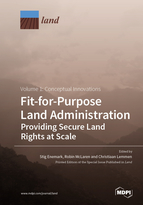Fit-for-Purpose Land Administration-Providing Secure Land Rights at Scale
A special issue of Land (ISSN 2073-445X).
Deadline for manuscript submissions: closed (31 March 2021) | Viewed by 104401
Special Issue Editors
Interests: land governance; land administration; land tenure; cadastre; land use planning; spatial information management; capacity development
Interests: land reform programmes; integrated geospatial information frameworks (IGIF); crowd sourcing methodologies; space-data-driven innovations
Interests: land administration; cadastre; land information systems and modelling; pro-poor land recordation
Special Issues, Collections and Topics in MDPI journals
Special Issue Information
Dear Colleagues,
Land administration systems provide countries with an infrastructure for implementation of land policies and land management strategies in support of sustainable development. In many developed countries, these systems are well developed and provide a kind of backbone in society in support of efficient land markets and effective land-use management. In most developing countries, however, up to 90 per cent of the land and people are outside of the formal systems, which serve mainly the elite.
The majority of these people outside the system are the poor and most vulnerable. This lack of secure tenure creates significant instabilities and inequalities in society and severely limits citizens’ ability to participate in social and economic development. It also undermines better land use and environmental stewardship and deters responsible private investment due to the associated land risk.
Attempts to introduce conventional (western style) land administration solutions to close the security of tenure gap have lacked success. New innovative solutions are required to build affordable, pro-poor, scalable, and sustainable systems to identify the way all land is occupied and used. The fit-for-purpose (FFP) approach to land administration has emerged as an opportunity for developing countries in this regard. It offers a viable, practical solution to quickly and affordably provide security of tenure for all and to enable control of the use of all land.
In this issue, we invite papers focusing on designing and building cost-effective land administration systems that provide secure tenure for all using an attainable, participatory, and flexible approach. The focus of the papers may be on—but not limited to—the following themes:
- Discussion and assessment of the FFP approach and the embedded spatial, legal or institutional aspects within country-specific contexts;
- The key drivers, such as innovative technology development and the Global Agenda 2030;
- Experiences of pro-poor land recordation and lessons learnt related to pilot projects or especially full-scale country implementation, including approaches to maintenance;
- Spatial, legal, and institutional issues related to covering rural villages and land use, customary tenure areas, and urban or peri-urban informal settlements;
- Policy and strategy development processes at governmental level;
- Approaches to service provision at scale, including the bundling of land administration services with other services to citizens and communities, related to, e.g., land-based financing, agricultural production, and co-operative capacity development;
- Cost-effective approaches to ensure availability, accessibility, and integration of land-based data from different sources;
- Land registration and dispute management in conflict-affected settings;
- Capacity development activities at societal, institutional and individual levels, including the private sector, to ensure that projects are sustainable; and
- Constraints related to lack of political will or vested interests of various kinds of stakeholders.
Prof. Stig Enemark
Dr. Robin McLaren
Prof. Dr. Christiaan Lemmen
Guest Editors
Manuscript Submission Information
Manuscripts should be submitted online at www.mdpi.com by registering and logging in to this website. Once you are registered, click here to go to the submission form. Manuscripts can be submitted until the deadline. All submissions that pass pre-check are peer-reviewed. Accepted papers will be published continuously in the journal (as soon as accepted) and will be listed together on the special issue website. Research articles, review articles as well as short communications are invited. For planned papers, a title and short abstract (about 100 words) can be sent to the Editorial Office for announcement on this website.
Submitted manuscripts should not have been published previously, nor be under consideration for publication elsewhere (except conference proceedings papers). All manuscripts are thoroughly refereed through a single-blind peer-review process. A guide for authors and other relevant information for submission of manuscripts is available on the Instructions for Authors page. Land is an international peer-reviewed open access monthly journal published by MDPI.
Please visit the Instructions for Authors page before submitting a manuscript. The Article Processing Charge (APC) for publication in this open access journal is 2600 CHF (Swiss Francs). Submitted papers should be well formatted and use good English. Authors may use MDPI's English editing service prior to publication or during author revisions.
Keywords
- Fit-for-purpose land administration
- Spatial, legal, and institutional frameworks
- Land tenure security
- Pro-poor land recordation
- Land governance reform
- Poverty reduction
- Capacity development
- Cost effectiveness
- Sustainability
- Innovative technology








